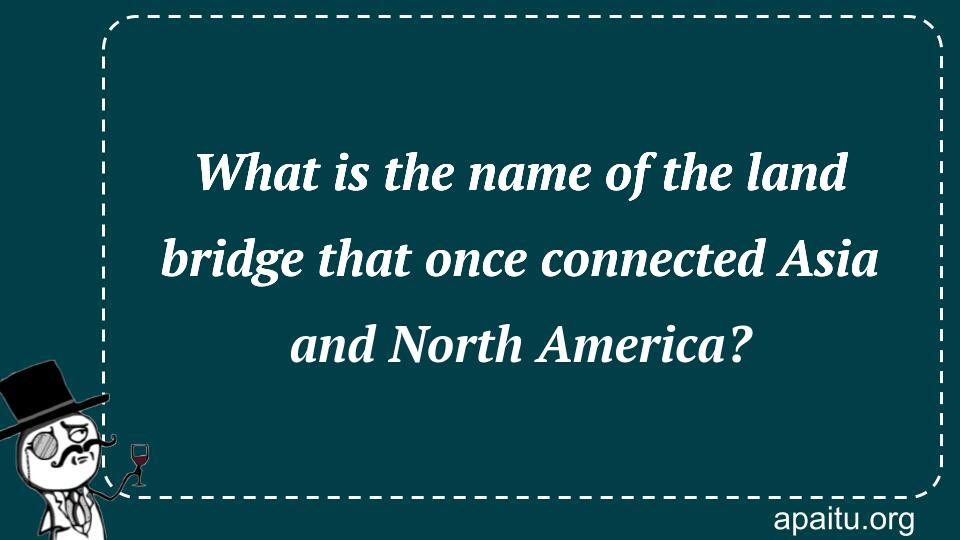Question
Here is the question : WHAT IS THE NAME OF THE LAND BRIDGE THAT ONCE CONNECTED ASIA AND NORTH AMERICA?
Option
Here is the option for the question :
- Beringia
- Isthmus of Panama
- Sinai Peninsula
- Doggerland
The Answer:
And, the answer for the the question is :
Explanation:
Fray Jose de Acosta, a Spanish missionary, first suggested the idea that Asia and North America were previously united by a land bridge in 1590. The fact that the Bering Strait between Russia and Alaska was dry land at various points was not recognised until the 20th century, when a complicated array of geological and paleontological evidence led to this conclusion. During the Pleistocene epoch, land that joined the two continents was exposed because sea levels dropped by as much as 400 feet as a result of widespread glaciation. Although ‘bridge’ might imply a tiny strip of land, Beringia might be up to a thousand miles wide at different times. After the Pleistocene ice age ended, the land bridge between the two continents was submerged once more. Some scientists argue that it is more likely that humans arrived in North America via boat, casting doubt on the widely held theory that they arrived via Beringia.

Beringia: The Lost Land Bridge Connecting Asia and North America
In the annals of Earth’s history, there have been moments of grandeur and transformation that have shaped the course of life on our planet. One such remarkable phenomenon occurred thousands of years ago, when a vast land bridge emerged, connecting the continents of Asia and North America. This bridge, known as Beringia, played a pivotal role in the migration of species and the development of human civilizations. Today, Beringia may have vanished beneath the waves, but its legacy continues to captivate scientists and enthusiasts alike, unraveling the mysteries of our ancient past.
Beringia, at its peak, spanned an impressive expanse of land, stretching over 1,500 kilometers (930 miles) from east to west. It encompassed what is now the Bering Strait, a narrow body of water that separates the Russian Far East from Alaska. The land bridge emerged during the last Ice Age, when massive ice sheets locked up vast amounts of water, causing sea levels to drop significantly. As a result, an expansive corridor emerged, connecting the two continents.
The name “Beringia” is derived from the Bering Strait, which was named after the Danish explorer Vitus Bering, who ventured into the region in the 18th century. However, the existence of this land bridge remained unknown to the wider world until the early 20th century when scientists began to piece together evidence of its existence.
One of the most significant aspects of Beringia was its impact on the migration of flora and fauna. During the Ice Age, numerous plant and animal species took advantage of the newly formed land bridge to traverse between Asia and North America. This allowed for the exchange of genetic material, leading to the intermingling of diverse populations and the spread of new species. Some notable examples include the woolly mammoth, the steppe bison, and the Yukon horse, all of which roamed freely across Beringia.
However, it was not just the animal kingdom that benefited from Beringia. The land bridge also played a crucial role in the human settlement of the Americas. Archaeological evidence suggests that early humans, possibly originating from Asia, used Beringia as a migratory route to enter and populate North America. These intrepid explorers ventured across the vast expanse of Beringia, adapting to its unique environment and eventually spreading throughout the continent.
The study of Beringia has provided valuable insights into the history of human migration. It is believed that the first humans to cross Beringia did so around 20,000 years ago, during a period known as the Late Glacial Maximum. These early settlers, known as the Paleo-Indians, gradually dispersed across the Americas, establishing diverse cultures and societies. The descendants of these ancient pioneers include the Indigenous peoples of the Americas, who have inhabited the land for thousands of years.
As the Ice Age came to an end and t